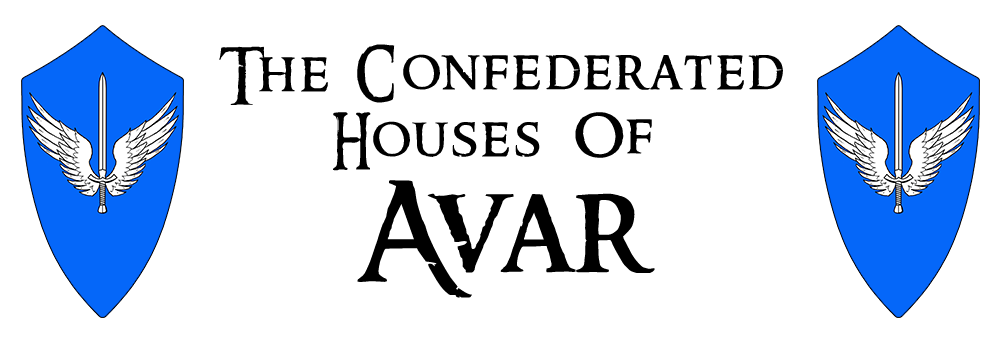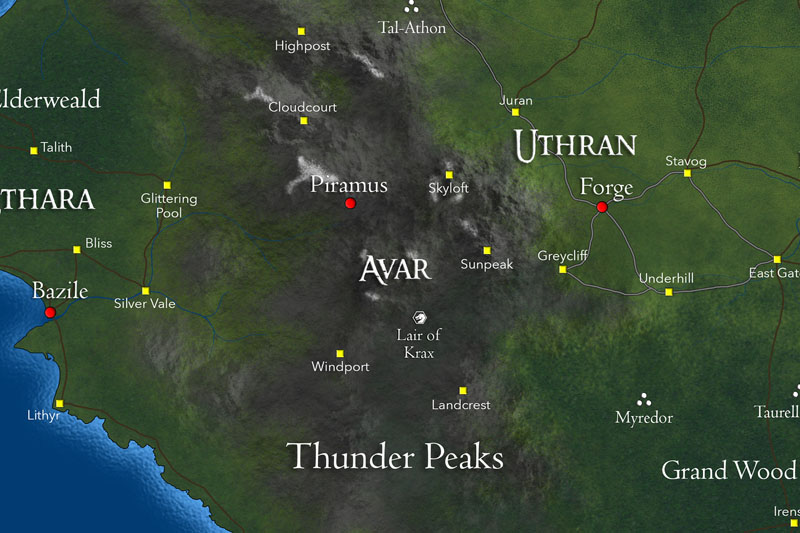
"May you be raised upon Angel's Wings"
-Avarian toast
![]()
|
|
| Proper Name | The Confederated Houses of Avar |
| Ruler | His Supreme Aerial Eminence, Master of the Piramus Council, Doraki Chandok Arantee, Exalted Champion of the Sky |
| Estimated Population | 2,200,000 |
| Demographics | Avarian 94%, Human 1%, Dwarven 1%, Elven 1%, Orc 1%, Ogre 1%, Grum 1% |
| Adjectival/Demonym | Avarian/Avarians |
| Languages | Avarese 90%, Northern 4%, Elven 3%, Dwarven 3% |
| Capital City | Piramus (Population: 9,800) |
| National Colors | Blue and white. |
| Year Founded | 879 |
| Currency | Avarian |
| Natural Resources | Lumber, llamas, iron ore, cotton, wool, goats |
| Manufactured Goods and Major Exports | Timber, textiles, feathers, clothing |
| Wealth | Wealthy |
| Government Type | Aristocracy |
| Government Stability | Stable |
| Allies | Ethara, Uthran, Cyrell |
| Enemies | None |
| Technology Level | Dark Ages |
| Primary Religions | Arros and Setharus |
| Other Religions | None |
| Climate | Temperate |
| Approximate Land Area | 1,050,000 square kilometers |
| Arable Land | 9% |
| Terrain | Mountainous |
 |
|
![]()
Avar is a group of seven cities and numerous villages in the northern stretches of the Thunder Peaks. These communities are bound only by race. Avar is almost totally Avarian. A handful of other races live as permanent or transient members of Avar.
![]()
Avar is a very mountainous region since it is entirely confined to the Thunder Peaks. Avarian cities are built nestled among the peaks, often perched upon breathtaking cliffs, affording the birdfolk spectacular vistas of their mountain home. Avar is entirely a high altitude nation as its towns are all located above 5,000 feet with some villages as high as 12,000 feet.
![]()
Mountain goats, llamas and bears are common in Avar. At high altitudes, herds of thunderbeasts can be found grazing and these beasts provide the avarians with a ready source of fresh meat. The rare corrak, the largest bird on Khoras, is protected by avarian law. Both forest lords and iron wood trees grow in the lower slopes and foothills of the Thunder Peaks.
![]()
The northern Thunder Peaks were home to seven great clans of mountain dwelling humans. The Vanoi and their mining camps, the forest dwelling Agir and their timber towns, the Chaunta's farming communities, the goat herding Echin, the deeply religious Chael, the magical Syrini and the cliff dwelling Alladan. The clans of the Thunder Peaks were a free and proud people who bent the knee to no king or noble lord. These clans shared a common ancestral background, dialects of a central language and the worship of the winged god, Avos, the Sky Lord, whose avatars were the eagles of the skies.
Many of these villages were decimated when the Sundering occurred and the central towns of each clan took in the refugees during the World Storm. These seven clans came together and shared resources to survive those dark days. In the years that followed, the people of the mountains, like so many other cultures, began to change and mutate. The radiation from the fractured sun brought on an accelerated mutation in the clans. Each generation born to the mountain people was markedly changed. The mountain folk grew smaller, more fine boned and more animalistic. Fingers elongated and webbed fingers began batlike wings. Hair grew more coarse and eventually turned to feathers. With the passage of centuries, the people became more and more birdlike. By 1100 CY, they were noticeably demi-human and by 1600 CY, they were completed avian in nature.
The seven towns have been completely rebuilt to accomodate the changing physical nature of its people. The ability to fly greatly changed their architecture. Over the long centuries, stairways and curtain walls gave way to tall towers, great domes and sky doors. Bridges vanished and balconies sprouted from every surface.
Although the seven clans have suffered tensions, they have lived in relative peace for several centuries.
![]()
No central government exists for Avar, although Piramus is the largest of the seven cities and often leads by example. Many consider Piramus the unofficial capital of the nation. Each city is ruled separately by its own central council. Each council conducts all affairs : making laws, judging civil offenses, commanding the military and running the city. Council members are appointed by the Council. Individuals are selected from the population on the basis of wealth, personal status, past accomplishments, etc. Only males are eligible and membership is for life.
![]()
The city council for each city also conducts all legal affairs : interpreting laws, judging crimes, determining and executing punishment, etc.
![]()
Each city has its own military force. The avarians prefer to fight from the air with skybows, strafing runs and bombing tactics. Usually about 5% of an avarian population is engaged in the military.
![]()
The economy of Avar is based upon its resources of stone, wood and a variety of mountainous flora. Transportation of goods is easily accomplished with neighboring countries because of the flight capability of Avar's citizens.
![]()
Avarians are culturally superior to all other races (or so they say). They enjoy many forms of arts, much of which is very visual in nature. But their cities also offer musical presentations at the theatre and aerial dancing (an art form unique to the avarian culture).
![]()
Magic is considered a respectable profession among the avarians. Those who excel at the craft are revered. There are several good schools of magic and several renowned avarians wizards in this mountain nation.
![]()
Male Names
Altunar, Batar, Chagar, Chulun, Dajar, Eyrden, Ganzar, Jargul, Kazar, Maldakar, Nubolar, Ogubar, Parath, Silar, Tugular, Valar
Female Names
Biyarma, Chuga, Dorjia, Enuba, Fenima, Guma, Hinda, Jarga, Khishiga, Mangara, Narutya, Oguba, Paratha, Suvina, Uskia
Notable Noble Family Names
Razorbeak, Longfeather, Brightplume, Broken Talon, Wingsoar
![]()
| Name | Population | Notes |
| Cloudcourt | 9,100 | This beautiful city houses the Avarian magical academy and universities. It also boasts an amazing multi-level museum that draws fascinated scholars from all over the western countries. So intent on showing off this marvel to their inferior human friends are the locals, that they've strived to make it reachable to everyone. Therefore, the Cloudcourt museum is the only building in the whole Avarian nation that contains a staircase. |
| Highpost | 8,200 | The northern city of Highpost conducts some limited trade with the nearby dwarven nations. The Dwarves are mainly interested in the high quality stone found at the higher elevations of this particular region of Avar. |
| Landcrest | 5,300 | Landcrest conducts major trade with all of southwestern Ithria. Although small in size, it is very prosperous. |
| Skyloft | 7,500 | Skyloft has the highest altitude of any Avarian city. It caters mostly to the wealthy. |
| Sunpeak | 4,600 | Renowned for its architecture, this beautiful community is favored by retired artisans, who build vacation homes here. |
| Windport | 8,700 | This city is situated in such a windy area that the natives utilize it for recreation in a very unique way. Called "Cascading", it involves using the river of wind to gracefully glide along the edges of the mountaintops, sometimes mere inches from the perilous rock. This sport is very popular with reckless young warriors, who enjoy showing off for members of the opposite sex. Adults discourage cascading, regarding it as foolish and stupid. |
![]()
Assan, Hanei, Jekawa, Jyr, Kaelok, Lethor, Lisk, Rai, Solar, Sonross, Spino, Vesgoi, Veshia
![]()
Because avarians can fly, and take great pride in that ability, the nation of Avar has no roads. Avarians travel everywhere by flying. Goods are typically transported in small amounts by flight as well. Flyers rest each night at any of numerous avarian mountain villages between major towns. Each village is roughly a day's flight to the next. Those few individuals in Avar who are "walkers" move from city to city along any of numerous mountain trails. These mountain trails are rough, winding and narrow, barely big enough for a single cart. It is possible to travel on these mountain paths with a small cart, but it is slow and difficult. Large wagons cannot manage. Horses are slowed as well on the rough mountain paths, but are still faster than walking. For more information on travel and distance, see the Travel and Distance page.
| Typical Travel Time | ||||||
| Route | Terrain/Road Conditions | Distance | Walking | Wagon/Cart | Horse | Flying (Avarian) |
| Piramus - Cloudcourt | Mountains | 229 km | 31 days | 44 days | 18 days | 5 days |
| Piramus - Highpost | Mountains | 455 km | 61 days | 87 days | 34 days | 10 days |
| Piramus - Skyloft | Mountains | 200 km | 27 days | 39 days | 16 days | 4 days |
| Piramus - Sunpeak | Mountains | 315 km | 42 days | 60 days | 24 days | 7 days |
| Piramus - Landcrest | Mountains | 557 km | 75 days | 107 days | 42 days | 12 days |
| Piramus - Windport | Mountains | 403 km | 54 days | 77 days | 30 days | 9 days |
| Piramus - Silver Vale (Ethara) | Mountains | 499 km | 67 days | 96 days | 38 days | 10 days |
| Piramus - Glittering Pool (Ethara) | Mountains | 378 km | 51 days | 72 days | 28 days | 8 days |
| Cloudcourt - Highpost | Mountains | 235 km | 32 days | 45 days | 18 days | 5 days |
| Skyloft - Sunpeak | Mountains | 218 km | 30 days | 42 days | 16 days | 5 days |
| Windport - Landcrest | Mountains | 289 km | 39 days | 56 days | 22 days | 6 days |
| Cloudcourt to Juran (Uthran) | Mountains | 430 km | 58 days | 82 days | 32 days | 9 days |
| Skyloft - Forge (Uthran) | Mountains | 326 km | 44 days | 63 days | 24 days | 7 days |
| Sunpeak - Greycliff (Uthran) | Mountains | 165 km | 22 days | 32 days | 12 days | 4 days |
| Piramus - Lair of Krax | Mountains | 342 km | 46 days | 66 days | 26 days | 7 days |
| Landcrest - Dothan (Bathynia) | Mostly Mountains | 520 km | 70 days | 100 days | 38 days | 11 days |
| Landcrest - Erencil (Cyrell) | Mountain, Hill and Forest | 622 km | 36 days | 40 days | 20 days | 13 days |
| Windport - Silver Vale (Ethara) | Mostly Hills | 454 km | 37 days | 30 days | 11 days | 10 days |
| Windport to Dothan (Bathynia) | Mostly Mountains | 535 km | 72 days | 102 days | 40 days | 11 days |
![]()
This website was last updated April 30, 2025. Copyright 1990-2025 David M. Roomes.